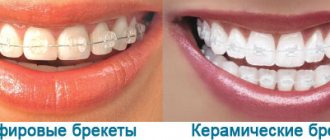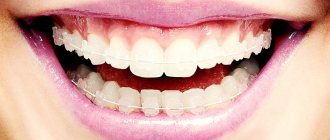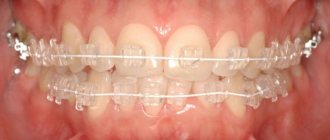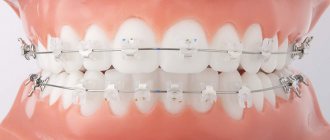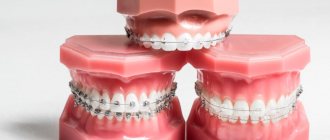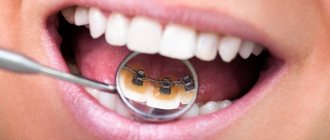Home » Braces systems » Choosing braces. Which systems are better to install?
Pathological bite today is considered one of the most common dental problems. This defect affects approximately 10% of the population. The danger is that such a violation not only causes a cosmetic defect on the face, but also leads to early tooth loss and the possibility of various diseases of the digestive tract. In this case, poorly ground food penetrates into the stomach cavity, which leads to the fact that the digestive organs receive a double load, associated with the need for additional processing of the incoming food substance. Over time, an inflammatory reaction begins in organ tissues.
The most suitable way to treat malocclusion is considered to be the installation of a special corrective structure (braces) on the teeth. It is fixed on the dentition, which is subject to alignment. With the help of braces, you can correct your bite at almost any age. It is most rational to do this in childhood, when the final ossification of the jaws has not yet occurred and it is much easier to move dental units in the required direction.
Modern orthodontics makes it possible to correct teeth in adult patients who did not undergo the treatment procedure at a young age. In addition, there are situations when dental disorder occurs precisely in adulthood:
- during the period of appearance of “wisdom” teeth, displacing the dental row;
- after resection of unhealthy dental units, when neighboring teeth move into the free space.
Orthodontic therapy in such cases is the optimal way to eliminate the anomaly that has arisen.
The questions “How do braces work?”, “Which ones are better to choose?” is of interest to every person who is faced with the problem of crooked teeth and wants to correct the defect. In short, the corrective effect is achieved through prolonged, precisely thought-out pressure on the teeth with orthodontic arches. Thanks to the targeted effect of traction, crooked teeth are gradually “stretched” in the right direction and take the correct position.
Any of the modern braces systems can correct the bite properly. But the variety of products offered makes us think about which of them has the most advantages and which one should be preferred in the treatment of a child, teenager and adult? All this will be discussed further.
How to choose braces?
Before making a difficult choice, you need to undergo a diagnosis from an experienced orthodontist. The specialist will analyze the condition of the oral cavity, the nature and severity of the defect, and potential ways to eliminate the anomaly. After this, the doctor will provide the patient with a detailed overview of braces, describing their types and the main features of each.
When choosing braces, the patient’s opinion must be taken into account. Important points are the aesthetics of the system, the duration of the therapeutic course, cost, etc. Taking into account all the “subtleties”, you can make the right choice - install a design that meets the client’s wishes and guarantees a high-quality therapy result.
Types and materials
Among the types of bracket systems that differ from each other in the material of manufacture, there are:
- metal;
- ceramic;
- plastic;
- sapphire;
- titanium;
- combined.
Braces also vary in location on the teeth:
- vestibular – external, do not affect the speaker’s diction;
- lingual – internal braces. During adaptation they can greatly influence diction.
Vestibular or lingual braces – which is better?
Vestibular structures are installed on the outer surface of the dentition, and lingual ones are attached to the inner surface. The first type of orthodontic products is clearly visible to others, while the second allows you to keep the therapy process a secret. Both types of systems have their own characteristics, which should be familiarized with before making a choice in favor of one of the options.
The vestibular brace system is installed on the outer surface of the dentition
The process of correcting malocclusion using a vestibular structure has the following positive qualities:
- relatively reasonable cost;
- absence of diction disorders and discomfort while wearing;
- shorter course of treatment.
The disadvantages include cosmetic imperfections. As mentioned above, the vestibular systems cannot be hidden from prying eyes; they are quite noticeable on the teeth.
The lingual brace system is attached from the inside
Features of lingual constructions :
- aesthetics, invisibility to others;
- the ability to constantly monitor movements in the dentition (the result can be observed in the mirror);
- high price;
- extended correction period;
- discomfort - change in speech, difficulty eating (these phenomena in most cases disappear after the adaptation period has passed).
In addition, there are certain contraindications to the installation of lingual systems.
Comparison of systems up close
The choice of the type of orthodontic structure depends on what exactly is the patient’s priority: a shortened course of treatment, price or aesthetics. If it is fundamentally important for a person that the treatment does not become public knowledge, then it is better to choose the lingual system. If you want to straighten your teeth as quickly and inexpensively as possible, then the vestibular type of device would be the best option.
Children usually have vestibular systems installed. This is due to the fact that such products cause less discomfort to the child and allow the defective bite to be eliminated more quickly.
Final tables comparing types of structures
To understand which braces are best to install for defects in the dental system, we suggest that you familiarize yourself with the summary information presented below:
| Sign | Vestibular braces | Lingual braces |
| Efficacy of therapy | High | Sometimes it works more effectively, in other clinical cases it does not have a sufficient effect |
| Duration of treatment, years | 1,5-2 | 2-3 |
| Design reliability | Excellent durability | Sensitivity to external influences |
| Popularity | Very popular | Installed less frequently due to unattractive cost |
| Aesthetic component | Low or medium | Invisible to others even with a wide smile |
| Difficulty of fixation | Not difficult | Quite difficult to attach |
| Hygienic care | Standard Procedures | Very difficult to care for |
| Adaptation period | Just a few weeks | Long, up to 3 months or more, sometimes patients never get used to the accessory |
| Wearing comfort | Doesn't cause discomfort | Inconvenient |
| Presence of pain | Minor soreness | Hurt |
Comparative analysis of accessories made from various materials:
| Characteristic | Metal braces | Ceramic systems | ||
| Classic | Self-ligating | Classic | Self-ligating | |
| Visibility | Visible due to contrast with enamel | Hidden | Barely distinguishable | Hidden behind teeth |
| Cost, thousand rubles* | from 80 000 | from 110 000 | ||
| Result in severe cases | Highly effective for seemingly hopeless deformities | Effective for most problems | Coping with advanced pathologies | |
| Convenience | Affects soft tissues | Injures the mucous membranes and tongue, causing diction problems | Rub during the first week of wearing | After the adaptation period, wounds can be avoided if you are careful |
| Hygiene | Difficult to clean | Cleans quickly, but is fragile and requires careful handling | ||
| Main disadvantage | Noticeable when communicating | Expensive | ||
*To get accurate prices for different types of turnkey correction, go to the Dentics website, or better yet, make an appointment and find out from the orthodontist personally which option is right for you.
Which braces to choose – ligature or non-ligature?
Depending on the design, there are two types of braces:
- ligature - arches are attached using elastics or wires;
- non-ligature – the arch is attached using a special orthodontic mechanism.
If you install ligature braces, then you will need to visit the doctor once a month to correct the installed device. This system is budget-friendly, but it requires more careful care, and the elastics are very “eye-catching” (teenagers often choose colored elastic bands, creating their own individual style).
The ligature-free system is very comfortable to wear. To correct it, you need to visit the orthodontist less often (about once every two months).
Comparison table of characteristics
Comparing the models presented in the rating, we created a special table to make the characteristics more obvious and understandable:
| Name of the bracket system | View | Manufacturer country | Purpose |
| Damon bracket system (DAMON 3MX) from ORMKO | Metal | USA | Complex dental pathologies |
| ALEXANDER bracket system from ORMKO | Metal | USA | Correcting your bite at any age |
| FORESTADENT 2D braces | Lingual (invisible) | Germany | Simple pathologies and malocclusion, correction of deep bite |
| Ligature-free braces Innovacion | Lingual (invisible) | USA | Alignment of teeth with varying degrees of pathology |
| STB bracket system | Self-ligating braces | Italy-Japan | Complex dental pathologies |
| ORTHOS bracket systems from ORMKO | Ligature system | USA | Correction of bite in children, attachment to unerupted teeth |
| Gemini metal braces | External ligature braces | USA | Elimination of serious dental growth abnormalities |
Which braces are the best in terms of material?
Braces are made from different materials. Depending on this indicator, systems are:
- Metal. Pros: reliability, functionality, efficiency, versatility, low price. The downside is cosmetic imperfection, because of which many patients do not decide to install such a product.
- Ceramic. Advantages: aesthetics, ease of use, durability. You can choose the color of medical porcelain to match the patient’s teeth or make the braces transparent.
- Sapphire. Pros: aesthetics, comfort to wear. Disadvantages: high price, relatively low strength, inability to correct serious malocclusion pathologies.
- Plastic. There is only one plus - cheapness, but there are many disadvantages: fragility, inconvenience, a high probability of staining with food pigments, etc. Experts advise choosing such products with caution.
The most popular products are metal (they shorten the course of treatment) and ceramic (they add aesthetics to the smile). In especially severe cases, malocclusion can only be corrected with the help of a metal system. Adult patients often choose systems made of precious metals - they look impressive and stylish, but are expensive. Children, as a rule, have traditional metal braces made of a safe alloy.
Metal
Orthodontists still install such systems, and this is understandable. When metal braces began to be equipped with locks instead of ligatures, their effectiveness increased. And the fact that this material is the most noticeable of all is not important for all patients. Both teenagers and many adults are no longer embarrassed to wear braces, since treatment by an orthodontist is perceived as an important and useful matter, and not at all a reason for jokes.
Close-up of metal non-ligature braces
pros
- If they are ligature-free, they work quickly and efficiently.
- Durable and easy to maintain hygiene.
- The most affordable.
- Ligation-free systems correct any violations quickly and efficiently.
- Easy to remove.
Minuses
- The most noticeable.
Metal system with bright ligatures
Metal braces
Metal structures are considered the most reliable. They effectively correct the bite and do not corrode. Wearing them does not cause discomfort in the oral cavity. At the same time, the systems are very affordable, and therefore have become most widespread among patients.
The advantages of such devices do not end there, as they:
- Not subject to deformation due to high strength
- Effective even when correcting very serious malocclusion pathologies
- Minimize discomfort during installation and wearing
- Even with the shortest treatment time they give the desired result
- Do not contribute to tooth enamel staining and do not change color until the end of treatment
However, all these advantages are hampered by some disadvantages inherent in metal structures: they do not look very aesthetically pleasing, they can cause an allergic reaction and they cannot be produced individually.
Rating of metal braces
Let's highlight several of the best, in our opinion, brands of bracket systems from trusted manufacturing companies:
- Damon. These braces minimize the treatment period and are a self-regulating system. They have a low degree of friction, an excellent sliding system, and comfortable locks. All these features have the best effect on the overall effect of treatment.
- Alexander. The systems are created from medical hypoallergenic steel, their installation is carried out without the use of ligatures. A special feature of these braces is their resistance to deformation due to their high degree of strength. The cost of structures ranges from 10,000 to 20,000 rubles.
- Ormco. These designs are classical ligature systems and have a slight thickness. All this contributes to their maximum wearing comfort. Systems can be made from an alloy with nickel or gold plating, or they can be created from durable titanium. Thanks to the design features, the best closure of the teeth is guaranteed. Even incomplete teething is not a contraindication to the installation of such braces. The price range is also impressive and depends on what material these systems are made of. If gold is used, the price of the devices will be very high - about 30,000 rubles, but titanium and nickel alloys will cost the buyer less - about 9,000 rubles.
Active and passive self-ligation
Self-ligation can be passive or active. With the active type of fixation, the bracket clip applies pressure and moves the archwire towards the base of the slot. The orthodontic arch, in turn, puts pressure on the clip. In the case of passive self-ligation, the cover fixes the archwire in the slot without exerting pressure on it. When closed, the bracket turns into a buccal tube: the static cover becomes the fourth wall of the groove, the arch moves freely and is not subject to force. Example: Damon Q.
Damon Q with orthodontic arch
Which braces are best for adults and pediatric patients? American orthodontist Vourdouris JC compared the frictional force of the arch in the bracket groove when using passive and active non-ligature structures. According to a study published in the American J. of Orthodontics & Dentofacial orthopedics, active systems operate with a high friction force of 31.0 g, while passive designs have a low friction force of 0.1 to 0.18 g.
The data obtained scientifically prove that passive self-ligating systems are able to interact with archwires throughout treatment without loss of force and provide a new standard of low friction when moving teeth. American scientists Thorstenson GA and Kusy supplemented the results of the study. Experts have found that when using the Damon System passive self-ligating system, there is significantly lower frictional resistance in dry and wet environments compared to active structures.
Studies conducted by orthodontists indicate the benefits of treatment with passive self-ligating braces.
Ceramic braces
In terms of aesthetics, few corrective systems can compare with models based on ceramics. A pleasant feature of these systems is that their color range is close to the natural color of tooth enamel, which makes the treatment process almost invisible to others.
In the process of creating devices, modern materials and special photopolymers are used. Thus, the consumer is guaranteed a high degree of convenience when using them.
The undoubted advantages of ceramic corrective systems include the least degree or complete absence of wearing discomfort, high strength, reliability of mini-locks, and hypoallergenicity. Another advantage is the durability of the original color, protection from injury to the soft tissues of the oral cavity, and the absence of psychological pressure when wearing them due to the highly aesthetic appearance.
The disadvantages of ceramic systems include an increased wear period, high cost, the possibility of demiralization of tooth enamel, and some discomfort when removing them.
Best lists
The presented bracket systems are the best in their categories. But we don't want to limit your choice to just these models. Therefore, we will highlight several systems recognized as the best in the categories:
- best price;
- metal;
- invisible.
Best price
In pursuit of beauty, you should be prepared to spend money. But there are bracket systems from a fairly budget category. The most budget braces are Pilot from domestic developers. The cost starts from 12,000 rubles. The total price depends on the complexity of the curvature and the need to pre-treat the teeth. The system is simple, performs its functions perfectly, although there is a drawback - not the most aesthetic appearance.
Bracket system
Metal
We have already indicated several metal bracket systems that are considered the best in their category: Ormco (from 15,000 rubles) and Damon (from 35,000 rubles).
But there are several other metal systems that deserve attention. Empower is an American system that belongs to the category of self-ligating composite type. Cost – from 30,000 rubles. And Evolution - the development of Italian orthodontists. Relatively inexpensive (from 20,000 rubles), but reliable braces that perfectly perform their main functions and protect teeth from damage and the development of pathologies.
Bracket system
Invisible
In-Ovation-L is perhaps the best invisible braces system worth considering. The system will not let anyone understand that the patient is undergoing quite serious treatment at this moment. The cost starts from 45,000 rubles, but has many advantages: discreet treatment, absence of ligatures, comfortable wearing and robust construction.
Bracket system
Sapphire braces
Of all the existing types of braces, sapphire structures are the most transparent, and therefore it is not surprising that the systems are chosen by those patients who, due to their work, must always be visible. In terms of cost, these braces are more expensive than all other types , and significantly so.
Corrective plates attached to teeth are created using special microcrystalline sapphires. The use of sapphire braces is limited to correcting only minor malocclusions; serious cases of correction require the use of other systems. The advantages of such designs are obvious:
- They are almost completely invisible on the teeth
- Smooth polishing of the plates minimizes the likelihood of injury to the oral mucosa
- They do not change color while wearing them.
- Patients quickly get used to them, as the devices are comfortable to wear and do not cause discomfort.
- Guarantees a flawless smile
- Fits securely and is easy to remove
Speaking about the disadvantages, it is important to note that sapphire braces are an expensive pleasure, and the treatment period with such braces is very long. During the entire period of therapy, the patient must pay increased attention to oral hygiene, and the fragility of such braces forces them to be treated with particular care. In addition, if the patient has serious problems with his bite, he will have to refuse to use these braces.
Rating of sapphire braces
Sapphire braces are rightfully considered innovative. The most commonly used are the following models:
- Ormco (Inspire ICE). A company from the USA, quite well known in the market of orthodontic structures. Produces plates with flawless polishing.
- American Orthodontics (Radiance). The company's particularly durable plates are known all over the world. Removing and reinstalling these plates is a breeze, thanks in large part to the reinforced structure in the center and lighter edges.
- Ortho Technology (Pure). Aesthetic and incredibly neat. They are distinguished by the presence of a coating of zirconium dioxide powder, so they are easy to remove and reinstall.
If we compare prices for different types of wafers, sapphire wafers are considered the most expensive, which is not surprising, given all their advantages. Based on cost, the devices are divided into 2 categories, and the price from 90 to 120 thousand rubles belongs to the “economy” category. A more advanced “business option” will cost even more – at least 120 thousand rubles and up to 200 thousand, sometimes higher.
It is also worth noting that the above-mentioned cost includes not only the sapphire braces themselves, but also payment for all stages of treatment - polishing, installation and subsequent removal of structures, creation of a permanent retainer.
Care Tips
Plaque and food particles accumulate under and around braces, which can lead to the development of tooth decay. Rules for caring for braces:
- regularly undergo professional oral hygiene,
- at home, in addition to the brush and paste, use an irrigator - it cleans the braces from food particles and plaque with a stream of water,
- use brushes to remove food debris from under braces,
- for the same purpose, use mono-beam and V-shaped brushes,
- After meals, use mouth rinse.
Plastic braces
These systems are considered a worthy alternative to metal structures, but, unlike the latter, they are characterized by an aesthetic appearance. Plastic braces are more similar to ceramic or sapphire structures than to metal systems.
It is quite simple to choose the color of plastic to match the enamel of the patient’s teeth. Plastic structures compare favorably with others due to their affordable cost, as well as wide possibilities in terms of color choice. The disadvantages include fragility, dietary restrictions (very strict requirements are imposed on the consumption of solid food) and a long correction period.
In addition, these braces often have to be changed, which does not have the best effect on the cost of treatment.
The best brands of plastic braces
Speaking about the rating, it is worth noting such brands as:
- Spirit Alexander. Made of transparent plastic and have a metal groove for the arc. These are the only aesthetic braces that have wings to correct rotations. The rotary wings are made of stainless steel, but when installing the braces system, they are hidden behind the wire arch, which allows you to maintain the aesthetics of the overall appearance of the braces. Spirit Alexander braces have rightfully gained well-deserved popularity among practicing orthodontists around the world. Comparable in aesthetic qualities to ceramic braces, plastic braces have a number of undeniable advantages: ease of installation, safety of removal from the enamel surface, adequate friction force.
- Spirit MB. Spirit MB plastic braces developed by ORMCO combine the excellent aesthetic characteristics and biomechanics of metal braces. Adhesion (sticking) to the enamel surface is achieved through mushroom-shaped undercuts on the base of the bracket, which create mechanical fixation comparable in reliability to metal braces. Spirit MB braces (Spirit) can be installed on any orthodontic adhesive. The use of a metal groove makes it possible to improve the sliding of the arc and more accurately implement the angular and torque characteristics inherent in the braces. It is not recommended for use on the lower jaw in cases of deep bite (braces can be worn out due to occlusal interference).
- Elegance. The amazing bonding characteristics of Elegance SL (Super Lock) provide excellent adhesion to tooth enamel. Features: Fiberglass reinforced composite, High break resistance, Computer generated design, Minimum size with maximum strength, Optimal sliding mechanism, Special metal slot design, One piece single groove and hook design, Maximum strength without cracking, Clear color marking system .
Plastic
One of the options that was popular in the past. But with the development of other systems, it became not the most preferable. Plastic braces are used together with rubber rings - ligatures, since metal locks with grooves for the arch are not installed in them. The fact that the material is less durable than metal or ceramics does not play a big role: breaking the bracket itself is quite difficult, especially if you follow the nutritional rules. However, they do have disadvantages.
Plastic braces with colorless ligatures
pros
- Transparent or white - look more aesthetically pleasing than metal.
- You can use bright colored ligatures, but then the meaning of transparent braces is lost.
- Affordable price.
Minuses
- They work more slowly than the self-ligating system, since over time the effect of the ligatures weakens and they hold the arch less well. The arc “slides” slower than in metal grooves.
- The braces and ligatures themselves turn yellow over time due to coloring foods (tea, coffee, berries, spices).
Which braces system is best for an adult?
Preference should be given to the design that can make the treatment course as effective, convenient and at the same time affordable for a person. When choosing braces, an adult should focus on the following parameters:
- Price . The patient must decide how much he can spend on orthodontic therapy and choose a device within an acceptable price range.
- Aesthetics and duration of treatment . If for the patient aesthetics is at the top of the list of product requirements, then a lingual or ceramic transparent design is chosen. If a person is interested in shortening the treatment period, then he can opt for a vestibular system made of metal.
- Number of visits to the orthodontist . If you choose a ligature system, you will have to go to the doctor more often. In order to correct a non-ligated product, the orthodontist’s office is visited less frequently.
Based on these factors, the patient will decide which brace design he likes best. But it should be remembered that the final verdict is made by the doctor, who also takes into account the characteristics and severity of the dental defect and the personal characteristics of the client’s oral cavity. The correct choice of a corrective system is the key to successful treatment.
Varieties based on material of manufacture
Braces systems are made from various materials. The basis is metal alloys, silver or gold plating, ceramics, and plastic.
Metal
The most common, cheap and reliable material. Metal braces are made from stainless steel, nickel or titanium.
Advantages:
- cheapness;
- small size, which reduces trauma to the mucous membrane;
- high strength;
- accessibility – used in every orthodontic clinic.
The main disadvantages of metal braces are possible allergies and low aesthetics. They are clearly visible on the teeth. However, this factor can be turned into a “highlight” - at the patient’s request, the ligatures are painted in different colors, and the brackets are made in the shape of stars, hearts, balls, and flowers.
Metal systems are produced by the following companies:
- Damon. Self-regulating devices that shorten the correction period. The average price is 20-30 thousand rubles.
- Alexander. Made from hypoallergenic medical alloys. Fastening is carried out with locks. Highly durable, comfortable and reliable. Cost – 10-20 thousand rubles.
- Ormco. Classical ligature systems. A special feature is its small size, which increases comfort. Systems with gold plating are available, as well as nickel and titanium braces. Can be used in open bites. Costs vary significantly depending on the type of material: from 10 to 30 thousand rubles.
Metal braces are the most durable and reliable among all types.
Ceramic
Classic ceramic braces are made from polycrystalline aluminum oxide. They are larger than metal ones, but have a number of advantages:
- invisibility - the product is selected exactly to match the color of the enamel;
- strength;
- do not oxidize or stain under the influence of pigments;
- rounded ends and smooth surface reduce mucosal trauma;
- quick adaptation period.
Important! Ceramic structures are only vestibular; they cannot be installed on the lingual surface of the teeth. Also not used for shortened crowns.
The main disadvantage of ceramic products is their high price. They cost 2–3 times more than standard braces.
There are several types of ceramic bracket systems:
- All-ceramic. Available in models Clarity Advanced (ligature), Damon Clear (no ligature). The most aesthetically pleasing, but the least durable. Price – 150-180 thousand rubles.
- Ceramic with a metal lock. The most commonly used is In-Ovation-C - the non-ligature type. The bracket and the groove for the arc are made of aluminum oxide, and the latch for the lock is made of a metal alloy. They cost about 130 thousand rubles.
- With metal groove. For example, Clarity braces with a ligature type of fastening. The price is around 40-50 thousand rubles.
- Combined. In such systems, the groove and lock are made of metal. They are the least aesthetically pleasing, but stronger than other products. Represented by Damon 3, Clarity SL models. The cost reaches 200 thousand rubles.
Ceramic ones are not so noticeable on the teeth, but are more expensive.
Sapphire
In fact, sapphire braces are a type of ceramic braces. The only difference is in the material. Monocrystalline aluminum oxide is used for manufacturing. This allows for transparency.
Additional Information! Ceramic structures are suitable for patients with darker and less transparent enamel. Sapphire – for white teeth with high transparency.
Advantages:
- high aesthetics - noticeable only upon close examination, sometimes glare in the sun;
- hypoallergenic;
- quick adaptation - diction and chewing functions remain almost unchanged;
- reduced trauma to the oral mucosa.
The disadvantages of sapphire designs include:
- high cost;
- the size of the brackets is larger than that of metal braces;
- Over time, coated metal ligatures can become stained, which reduces the aesthetics of a smile;
- low strength - sapphire products break under increased loads, this prolongs the duration of treatment.
Sapphire braces look beautiful, but do not withstand high loads.
On the dental market, sapphire braces are represented by the following models:
- Inspire ICE from the American company Ormco. The average cost is 150 thousand rubles.
- Radiance from American Orthodontics. The key feature is the reinforcement of the structure at the edges and in the center. Price – 160 thousand rubles.
- Damon Clear. The most popular and durable. They cost from 160 thousand rubles.
- Pure from the manufacturer Ortho Technology. Easy to put on and take off thanks to zirconium dioxide coating. They cost 150 – 180 thousand rubles.
Choosing braces for children
The process of choosing an orthodontic system for a child has its own nuances. The young patient needs to be provided with psychophysical comfort. It is necessary to minimize, as far as possible, all potential inconveniences associated with the operation of the correction device. At the same time, the main goal remains the final result - rational and quick correction of the dental defect.
Braces suitable for children should:
- effectively correct dental anomalies;
- carry out corrective work in the shortest possible period of time;
- ensure ease of implementation of hygiene measures relating to the oral cavity;
- be durable, comfortable to wear;
- to look nice.
Considering these requirements, we can say that it is better for children to install vestibular braces made of metal. Of course, such products are inferior to ceramic ones in terms of aesthetics, but this drawback can be eliminated by installing bright ligatures and colorful elastics, which are very stylish and are liked by many teenagers.
Braces - what are they and what are they for?
Braces are a permanent orthodontic device designed to correct malocclusion or unevenness of individual teeth. The system consists of clasps attached with dental glue to each tooth and a metal arch threaded through them. Along the edges of the dental row, the system is attached with rings to 6 or 7 teeth. The degree of tension in the arch allows the teeth to gradually move in the desired direction specified by the orthodontist. To ensure that the teeth move as they should, the doctor periodically monitors and adjusts the degree of arch tension. Different types of braces require different frequency of monitoring.
Braces are installed by an orthodontist after preliminary diagnosis and identification of the patient’s pathology.
Incorrectly selected or installed braces can lead to systemic disorders such as headaches, poor posture, decreased vision, and even cerebrovascular accidents.
It is very important to choose a dental clinic that has a positive experience in installing braces. You can do without negative side effects!
Braces allow you to straighten your teeth and correct your bite
Conclusion
Choosing the right brace system depends on many parameters. In modern orthodontics, there are many different designs, each of which has advantages, disadvantages and may be the best option for a particular situation. When choosing braces for malocclusion treatment, you must, in addition to your own requirements, consult with an experienced orthodontist. You can undergo a comprehensive examination and consultation with a doctor, and then get high-quality, effective braces in our dentistry.
Posted by:

